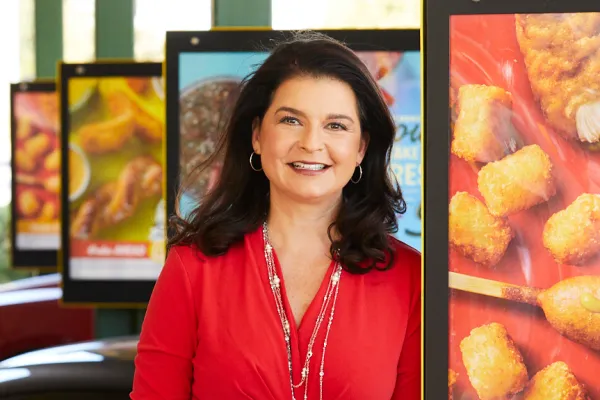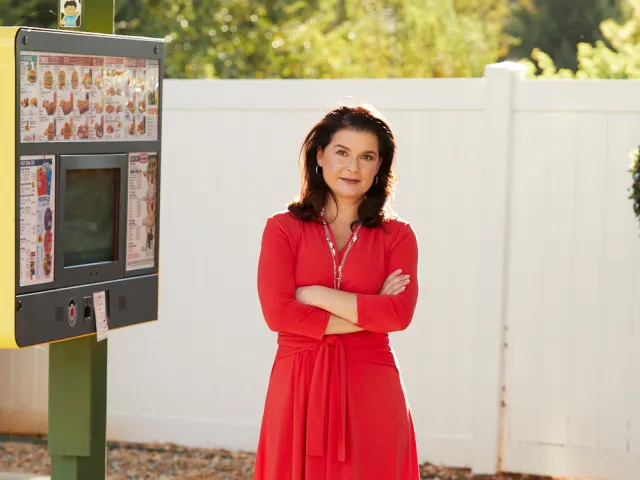Breaking Barriers at Sonic Speed
Alum News

Published December 9, 2019
Claudia San Pedro ’91 broke barriers as the first woman and first Latinx director for the Oklahoma Office of State Finance. It was a career high for the longtime public servant—but she had other aspirations.
She had always thought she would eventually transition to the corporate world, and after 12 years in the public sector, the time seemed right. She even had a short list in mind of Oklahoma-based companies to consider. Before she began looking, though, one of those on her list—Sonic, with its 3,600 retro-style drive-in restaurants—reached out to her. In 2006, San Pedro became treasurer and vice president of investor relations for Sonic Corp., the nation’s largest drive-in restaurant franchise, famous for its roller-skating carhops and its Coney dogs, Sonic Blasts and array of soft-drink flavor combos.
“It was perfect,” she remembers of switching to Sonic. “The company had a great reputation, great culture, and I thought when these opportunities come along, you never know when they’re going to come along again.” It must have been a good fit because in 2018, San Pedro was named president of the company, making her the first woman and first Latinx person to hold that title.
The job also brought her full circle to her youth. San Pedro, whose family emigrated from Mexico when she was 2 years old, grew up in Oklahoma, where Sonic originated in 1959. For her, going to the classic drive-in was part of growing up. “When you received a driver’s license, a rite of passage was taking your friends to Sonic,” she remembers. “I went to Sonic after school at least two to three times a week. We would order cherry limeades, cheese Tater Tots and onion rings and talk about school and friends. On Friday and Saturday nights cruising Sonic was standard to see who was out and where the fun was. After dances we would go to Sonic to eat, drink and compare notes.”

Photograph by Amanda Friedman
Here San Pedro talks about her journey to the top, the future of the fast-food business and how her love of economics influences her approach to management.
A Latina at the Table
What’s a little unique about my experience is I look white, so it’s not obvious that I am a person of color. I have family members who have beautiful brown skin, and it is very obvious. Their experiences are different for that reason. In terms of being a woman, I think my experience has not been very different than what you hear a lot. When I entered the senate staff’s fiscal office, it was about 50 percent each of women and men. As our careers progressed, I saw fewer and fewer women. When I went into committee hearings, it was all men.
Policies for the People
My first professional job after Smith was as a fiscal analyst for the Oklahoma State Senate. [It] was an amazing opportunity to truly appreciate the importance that state government and state public and fiscal policy play in the economic fabric and the quality of life for the people. I didn’t fully appreciate how important it was with respect to setting public policy that would impact education, the way we treat families and children that come through our system due to unfortunate life circumstances, the correctional system, or our roads and bridges.
Moving Sonic Forward
[As president of Sonic] I make sure we’ve got great talent and a great culture so … we can ultimately continue to grow the Sonic brand, which means increased sales and profits for our franchisees. Part of my role is to make sure that we have a clear sight of who we are as a brand and never lose our heritage and what our brand essence is but continue to innovate and reinvent ourselves.
Changing Flavors of Fast Food
Fast food used to be hamburgers and french fries, but a big portion of our menu is now snacks, like mozzarella sticks or Ched ’R’ Peppers. Also, we are now infusing the richness of our multicultural world into fast-food cuisine. As a Latina woman, I grew up with Mexican cooking, and flavors like chipotle were very common, though most people didn’t know what it was. Today chipotle is widely used and on many American fast-food menus.
Healthier Indulgences
People say they want to eat healthy, but they also like to indulge. At one point, we served salads, but we found consumers don’t want to eat a salad at Sonic. But they do want choices in portion sizes and ingredients. One innovative product we’ve created is the Sonic Signature Slinger. It’s a cheeseburger made with 100 percent pure beef and mushrooms, so it has lower calories than a typical burger, but still has the richness and flavor of a traditional all-beef burger.
Learning to Question
Smith was transformational for me. Up until college, I had a very successful, conventional academic career, and I was very much a rule follower. I didn’t question very much. At Smith, professors encouraged you to think critically, to understand the importance of analyzing every problem, whether looking at it from an economic, historical or political perspective.
The Balancing Act
I have a 16-year-old son and a 13-year-old daughter, and what keeps me sane is having an incredible support network. I could not do what I do without my husband, Paul Sund, who is absolutely amazing. My mom has been an incredible support, and I also have a small inner-circle group of friends. … What it comes down to is some days I’m a better mother than I am employee and leader, and some days I’m a better leader than I am a mother. But we need to be more forgiving of ourselves.
Looking Ahead
My goals over the next five years are to continue building the Sonic brand, using technology in a very strategic fashion to drive a better guest experience, to make our operators’ lives a little easier—and to create more job opportunities so more people can achieve what I consider the quintessential American dream. I can’t think of anything better.
Be Ready for Opportunity
It’s so important to be able to think critically, analyze situations and be open to new opportunities. Some of us know exactly what we want to be and how we want to get there. For others of us, which was my case, I wasn’t sure. I knew what was important to me, but what really helped me figure it all out was adapting to different situations. Don’t be afraid of failure; resiliency is one of the most important life skills you can learn.
This story appears in the Winter 2019-20 issue of the Smith Alumnae Quarterly.
SMITH ID
CLAUDIA SAN PEDRO ’91 President, Sonic Corp., a nationwide drive-in franchise
SENIOR HOUSE: Chapin (head of residence)
MAJOR: Economics
FORESHADOWED AT SMITH: San Pedro’s first campus job was in the Davis Center café making milkshakes and hamburgers. Later she was student bank president.
FURTHER EDUCATION: Master of business administration, University of Oklahoma
YES, THEY REALLY WEAR ROLLER SKATES AT SONIC
Most American fast-food restaurants long ago replaced their 1950s-style drive-in service with drive-through, take-it-and-go service. Sonic is a holdout and has built its nostalgic image on its drive-ins. Even now, like a scene out of American Graffiti, a trip to Sonic means cruising into a covered parking space, ordering dinner and having it delivered—with a peppermint—on a tray by a roller-skating carhop. Or, if midcentury nostalgia holds no appeal, most Sonics now have dining rooms and drive-throughs, too.
Also unique to Sonic is a drink menu that lets customers choose their own flavor combinations for drinks and slushes, with flavors like watermelon, blue coconut, blackberry, chocolate and mango, and candy add-ins like Jolly Ranchers. Its most popular flavor is cherry limeade, which the company boasts it sells enough of each year to fill 15 Olympic-size pools.
On that note, the company says it sells enough Tots to encircle the planet, twice; and enough footlong Coney dogs to border the 48 states that existed until 1959, the year Sonic sold its first dog. (Alaska now boasts a Sonic in Wasilla, but for the moment, Hawaiians must do without.)
Photograph by Amanda Friedman